what is the term used to describe a trait that is controlled by many genes?
Genes come in different varieties, called alleles. Somatic cells contain two alleles for every cistron, with one allele provided past each parent of an organism. Often, it is impossible to determine which two alleles of a gene are present within an organism'south chromosomes based solely on the outward appearance of that organism. However, an allele that is hidden, or not expressed by an organism, can nevertheless exist passed on to that organism's offspring and expressed in a later generation.
Tracing a hidden gene through a family tree
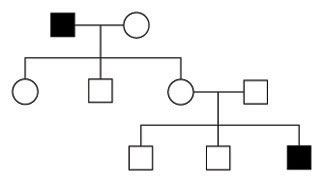
Figure 1: In this family pedigree, black squares indicate the presence of a particular trait in a male, and white squares correspond males without the trait. White circles are females. A trait in one generation tin exist inherited, but non outwardly apparent earlier two more generations (compare blackness squares).
The family tree in Figure i shows how an allele tin can disappear or "hide" in i generation and then reemerge in a later generation. In this family tree, the father in the first generation shows a particular trait (as indicated by the black square), only none of the children in the second generation evidence that trait. Nonetheless, the trait reappears in the third generation (black square, lower correct). How is this possible? This question is best answered past because the basic principles of inheritance.
Mendel's principles of inheritance
Gregor Mendel was the kickoff person to depict the manner in which traits are passed on from ane generation to the next (and sometimes skip generations). Through his breeding experiments with pea plants, Mendel established three principles of inheritance that described the manual of genetic traits before genes were even discovered. Mendel's insights greatly expanded scientists' understanding of genetic inheritance, and they also led to the development of new experimental methods.
One of the key conclusions Mendel reached after studying and breeding multiple generations of pea plants was the idea that "[you cannot] draw from the external resemblances [any] conclusions every bit to [the plants'] internal nature." Today, scientists use the word "phenotype" to refer to what Mendel termed an organism'due south "external resemblance," and the word "genotype" to refer to what Mendel termed an organism's "internal nature." Thus, to restate Mendel's conclusion in modern terms, an organism's genotype cannot exist inferred past merely observing its phenotype. Indeed, Mendel'south experiments revealed that phenotypes could exist hidden in one generation, only to reemerge in subsequent generations. Mendel thus wondered how organisms preserved the "elementen" (or hereditary material) associated with these traits in the intervening generation, when the traits were hidden from view.
How do hidden genes pass from one generation to the next?
Although an individual gene may code for a specific physical trait, that gene can exist in different forms, or alleles. One allele for every gene in an organism is inherited from each of that organism'due south parents. In some cases, both parents provide the same allele of a given gene, and the offspring is referred to as homozygous ("homo" meaning "same") for that allele. In other cases, each parent provides a unlike allele of a given gene, and the offspring is referred to equally heterozygous ("hetero" meaning "different") for that allele. Alleles produce phenotypes (or physical versions of a trait) that are either dominant or recessive. The dominance or recessivity associated with a particular allele is the result of masking, by which a dominant phenotype hides a recessive phenotype. By this logic, in heterozygous offspring simply the dominant phenotype will exist apparent.
The human relationship of alleles to phenotype: an example
Relationships betwixt dominant and recessive phenotypes can exist observed with breeding experiments. Gregor Mendel bred generations of pea plants, and as a consequence of his experiments, he was able to propose the idea of allelic cistron forms. Modern scientists use organisms that take faster convenance times than the pea plant, such as the fruit fly (Drosophila melanogaster). Thus, Mendel's primary discoveries will be described in terms of this modern experimental choice for the remainder of this give-and-take.

Effigy two: In fruit flies, two possible body color phenotypes are brown and black.
The substance that Mendel referred to every bit "elementen" is now known as the gene, and different alleles of a given gene are known to give rising to different traits. For instance, breeding experiments with fruit flies have revealed that a single gene controls fly body color, and that a fruit fly tin take either a brown torso or a black body. This coloration is a direct result of the body color alleles that a wing inherits from its parents (Figure two).
In fruit flies, the gene for body color has 2 different alleles: the black allele and the brownish allele. Moreover, brown torso color is the dominant phenotype, and black torso color is the recessive phenotype.
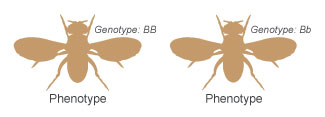
Figure 3: Dissimilar genotypes can produce the same phenotype.
Researchers rely on a blazon of shorthand to stand for the different alleles of a gene. In the case of the fruit fly, the allele that codes for brown body colour is represented by a B (because brown is the dominant phenotype), and the allele that codes for black torso color is represented by a b (because black is the recessive phenotype). As previously mentioned, each fly inherits ane allele for the body color gene from each of its parents. Therefore, each fly will carry two alleles for the body color gene. Within an individual organism, the specific combination of alleles for a gene is known as the genotype of the organism, and (as mentioned above) the physical trait associated with that genotype is called the phenotype of the organism. So, if a fly has the BB or Bb genotype, it volition have a brown torso color phenotype (Figure 3). In contrast, if a fly has the bb genotype, information technology will have a blackness body phenotype.
Dominance, convenance experiments, and Punnett squares
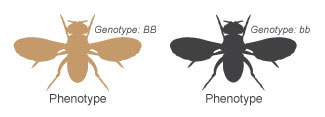
Figure 4: A brown fly and a black fly are mated.
The best way to understand the say-so and recessivity of phenotypes is through breeding experiments. Consider, for example, a convenance experiment in which a fruit fly with chocolate-brown body color (BB) is mated to a fruit fly with black body colour (bb). (The genotypes of these 2 flies are shown in Effigy 4.) The breeding, or cantankerous, performed in this experiment tin be denoted every bit BB × bb.

Figure five: A Punnett square.
When conducting a cantankerous, 1 way of showing the potential combinations of parental alleles in the offspring is to align the alleles in a filigree called a Punnett square, which functions in a manner similar to a multiplication tabular array (Figure 5).
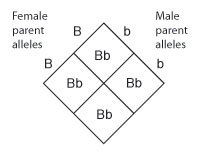
Effigy half-dozen: Each parent contributes i allele to each of its offspring. Thus, in this cantankerous, all offspring volition take the Bb genotype.
If the alleles on the outside of the Punnett square are paired upwards in each intersecting square in the grid, it becomes articulate that, in this particular cross, the female parent tin contribute only the B allele, and the male parent can contribute only the b allele. As a consequence, all of the offspring from this cantankerous will have the Bb genotype (Figure 6).
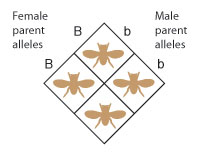
Figure 7: Genotype is translated into phenotype. In this cross, all offspring will have the brown body color phenotype.
If these genotypes are translated into their respective phenotypes, all of the offspring from this cross will have the dark-brown torso color phenotype (Effigy 7).
This upshot shows that the brown allele (B) and its associated phenotype are dominant to the black allele (b) and its associated phenotype. Even though all of the offspring have brown body color, they are heterozygous for the black allele.
The phenomenon of dominant phenotypes arising from the allele interactions exhibited in this cross is known as the principle of uniformity, which states that all of the offspring from a cross where the parents differ by only one trait will announced identical.
How tin can a breeding experiment exist used to discover a genotype?

Figure 8: A Punnett square can help make up one's mind the identity of an unknown allele.
Brown flies tin can be either homozygous (BB) or heterozygous (Bb) - but is information technology possible to make up one's mind whether a female person fly with a brown trunk has the genotype BB or Bb? To answer this question, an experiment chosen a examination cantankerous can exist performed. Test crosses help researchers determine the genotype of an organism when only its phenotype (i.e., its appearance) is known.
A test cantankerous is a breeding experiment in which an organism with an unknown genotype associated with the dominant phenotype is mated to an organism that is homozygous for the recessive phenotype. The Punnett square in Figure 8 tin exist used to consider how the identity of the unknown allele is determined in a examination cross.
Breeding the flies shown in this Punnett square will determine the distribution of phenotypes amid their offspring. If the mother has the genotype BB, all of the offspring will have brown bodies (Figure 9, Outcome one). If the female person parent has the genotype Bb, l% of the offspring volition accept brown bodies and fifty% of the offspring will have black bodies (Effigy 9, Outcome 2). In this way, the genotype of the unknown parent tin be inferred.

Again, the Punnett squares in this instance function similar a genetic multiplication table, and at that place is a specific reason why squares such as these work. During meiosis, chromosome pairs are split apart and distributed into cells called gametes. Each gamete contains a unmarried copy of every chromosome, and each chromosome contains ane allele for every gene. Therefore, each allele for a given factor is packaged into a carve up gamete. For example, a wing with the genotype Bb will produce 2 types of gametes: B and b. In comparison, a fly with the genotype BB will but produce B gametes, and a fly with the genotype bb will only produce b gametes.

Effigy x: A monohybrid cross between 2 parents with the Bb genotype.
The following monohybrid cross shows how this concept works. In this type of breeding experiment, each parent is heterozygous for trunk color, so the cross can be represented by the expression Bb × Bb (Figure 10).
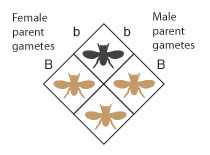
Figure xi: The phenotypic ratio is 3:1 (dark-brown trunk: black body).
The outcome of this cantankerous is a phenotypic ratio of 3:1 for dark-brown torso color to black body color (Effigy eleven).
This observation forms the second principle of inheritance, the principle of segregation, which states that the ii alleles for each factor are physically segregated when they are packaged into gametes, and each parent randomly contributes one allele for each gene to its offspring.
Tin ii dissimilar genes be examined at the same time?
The principle of segregation explains how individual alleles are separated amid chromosomes. But is it possible to consider how two dissimilar genes, each with different allelic forms, are inherited at the same time? For instance, can the alleles for the body color gene (brown and blackness) be mixed and matched in different combinations with the alleles for the eye color cistron (ruby and brown)?
The simple answer to this question is yes. When chromosome pairs randomly align along the metaphase plate during meiosis I, each member of the chromosome pair contains one allele for every factor. Each gamete will receive one re-create of each chromosome and one allele for every gene. When the private chromosomes are distributed into gametes, the alleles of the different genes they carry are mixed and matched with respect to one another.
In this example, at that place are ii dissimilar alleles for the middle colour factor: the Eastward allele for red centre colour, and the e allele for dark-brown eye color. The red (East) phenotype is ascendant to the brown (e) phenotype, so heterozygous flies with the genotype Ee will take ruby eyes.
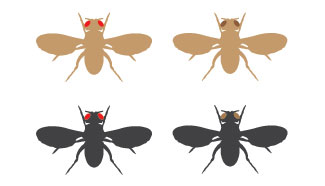
Figure 12: The four phenotypes that can result from combining alleles B, b, E, and due east.
When two flies that are heterozygous for brown body color and red eyes are crossed (BbEe X BbEe), their alleles can combine to produce offspring with four unlike phenotypes (Figure 12). Those phenotypes are brown body with crimson eyes, brownish body with brown optics, black body with red eyes, and black body with chocolate-brown eyes.
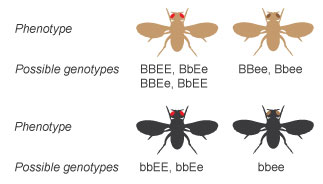
Figure xiii: The possible genotypes for each of the four phenotypes.
Even though only iv different phenotypes are possible from this cross, 9 different genotypes are possible, every bit shown in Figure thirteen.
The dihybrid cantankerous: charting 2 dissimilar traits in a unmarried breeding experiment
Consider a cross between two parents that are heterozygous for both torso colour and eye color (BbEe ten BbEe). This type of experiment is known as a dihybrid cross. All possible genotypes and associated phenotypes in this kind of cross are shown in Figure 14.
The four possible phenotypes from this cross occur in the proportions 9:3:3:ane. Specifically, this cross yields the post-obit:
- 9 flies with dark-brown bodies and red eyes
- 3 flies with brown bodies and brown eyes
- 3 flies with blackness bodies and red optics
- 1 fly with a black body and brown eyes
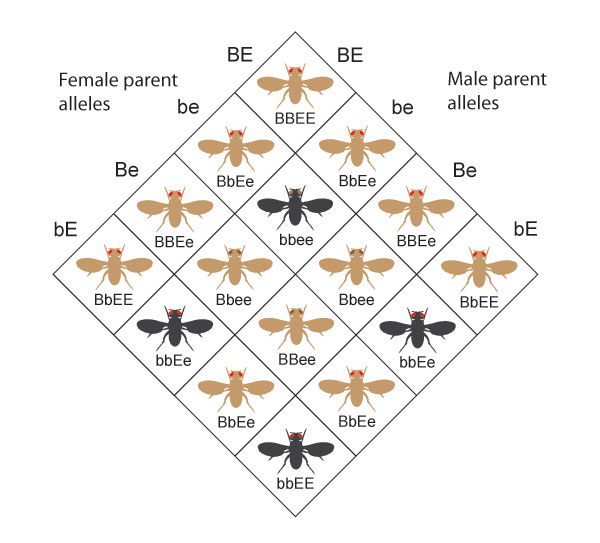
Figure 14: These are all of the possible genotypes and phenotypes that can result from a dihybrid cross betwixt two BbEe parents.
Why does this ratio of phenotypes occur? To answer this question, information technology is necessary to consider the proportions of the individual alleles involved in the cross. The ratio of brown-bodied flies to black-bodied flies is three:1, and the ratio of red-eyed flies to chocolate-brown-eyed flies is too 3:1. This means that the outcomes of body color and middle color traits announced as if they were derived from 2 parallel monohybrid crosses. In other words, even though alleles of ii different genes were involved in this cantankerous, these alleles behaved every bit if they had segregated independently.
The issue of a dihybrid cross illustrates the 3rd and final principle of inheritance, the primary of independent array, which states that the alleles for ane gene segregate into gametes independently of the alleles for other genes. To recapitulate this principle using the case to a higher place, all alleles assort in the same mode whether they code for body color solitary, heart color alone, or both body colour and eye color in the same cross.
The touch on of Mendel'south principles
Seminal experiments on inheritance
Mendel's principles can exist used to understand how genes and their alleles are passed down from 1 generation to the next. When visualized with a Punnett square, these principles tin can predict the potential combinations of offspring from ii parents of known genotype, or infer an unknown parental genotype from tallying the resultant offspring.
An of import question nevertheless remains: Exercise all organisms laissez passer on their genes in this way? The answer to this question is no, but many organisms practise showroom simple inheritance patterns like to those of fruit flies and Mendel's peas. These principles course a model against which different inheritance patterns tin be compared, and this model provide researchers with a fashion to clarify deviations from Mendelian principles.
Source: http://www.nature.com/scitable/topicpage/inheritance-of-traits-by-offspring-follows-predictable-6524925
0 Response to "what is the term used to describe a trait that is controlled by many genes?"
Post a Comment